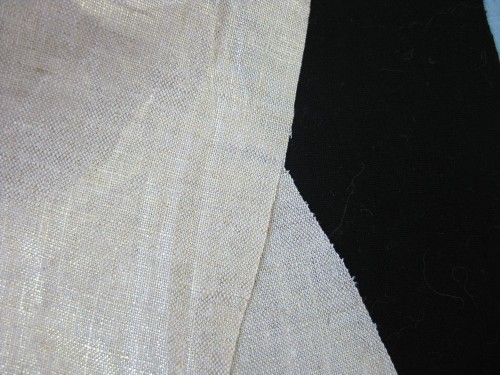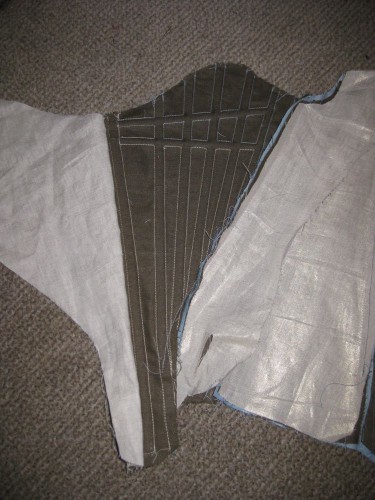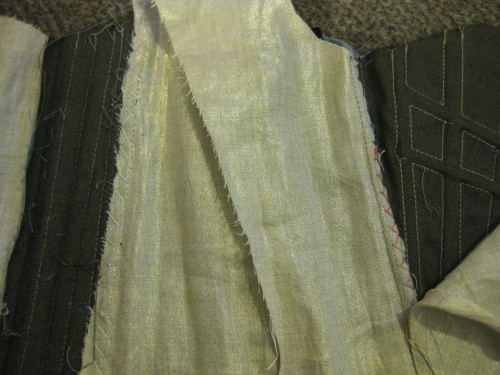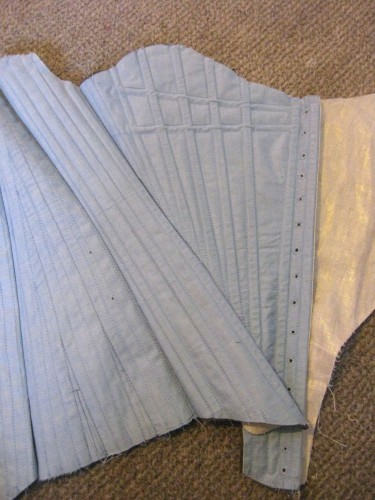Some time ago, I decided I needed another pair of stays, and started on a set. And they’ve been nothing but trouble since then. They are almost making #4 on the list of evil things.
First there was the fabric. I bought a bunch of linen with a gilded finish in a fabric sale, because it was soooo pretty, and I’m a magpie.
Linen is a great fabric for stays, right? And who doesn’t want a pair of gilded stays?
Linen is not a great fabric for stays if it warps. And gilded linen is an even worse choice if the minute you iron it, the gilded finish comes off, leaving you with plain, boring, ecru linen.
But I didn’t even get far enough into the stays to find these things out before it gave me problems, because it turns out that gilded linen is actually really, really hard to match for a lining. So I finally settled for black, because it was really the only thing I had that didn’t look hideous with it.
And, of course, the day after I cut out all the black lining pieces, I was at an op shop and found the perfect tightly woven blue cotton fabric for the lining. And it was only $2, so of course I bought it. And then went home, and glared at my black lining pieces, and then sighed, and re-cut the lining out of the blue.
So now I have an extra black lining cut for stays, and being the sort of person I am I don’t want to just toss it, so now I have to make yet another pair of stays. Out of the same pattern. And I wanted to try a different pattern next time. Grumble-grumble boo.
The pattern, now that I’ve mentioned it, is the same one that I used for my are-they-or-aren’t-they 1750s red cotton and linen stays.
I’m trying a new way of sewing the stays, where I sew the boning channels through the lining and the support fabric (a lovely non-warpy but not pretty-coloured brown linen), and sew the pieces wrong-sides together with the seam allowances facing out, and then put the gilded linen outer pieces over each pattern piece to cover the seam allowances. It’s quite similar to what I did with Ninon’s bodice.
You can see above how the gilded linen pieces are sewn with the seams at one edge, and then will be folded back over their pattern piece, and the edge folded under to cover the raw seam allowances.
I’m sure I read about this as a historically accurate type of stay construction, but these stays have been so evil that now I am convinced that I made it up in some horrible nightmare that convinced my mind I had read it, and now all this effort has been for naught.
Well, mostly naught, because they will still be wearable, if not historical. Sort of. We’ll see.
I’m also trying a new boning layout, also based on a source that I can no longer recall or find. I know I looked at pictures and stays and patterns to draw it, but between drawing out the boning layout and sewing it the pictures and stays and sources have all disappeared.
Typical of these stays.
You can see in the photo above the other ill-thought out, misbegotten, evil thing about these stays. They lace front and back. That means twice as many eyelet holes to do by hand. What was I thinking!
I’ve realised something writing this post. The more evil something is, the more I use italics. Mr Carpenter was right! Italics are evil! Or at least a sign of it.






They look freaking awesome to me! I’ve seen that boning layout too. It’s similar to Diderot, isn’t it? I have to agree about the gilded linen, that it would make the most epic pair of stays, so perrrdy, but what a bummer the gilt comes off when you iron it. What is that about?
I rear somewhere (or many places?) that stays were constructed with the outer fabric and the support layers sewn all together with raw seam allowances, and then the lining mounted inside, covering the raw edges, so it could be removed and replaced periodically. Just the reverse of how you’re doing it, so it makes total sense to me. I think I like your method far more than the one I use, which is bag lining and stitch-in-the-ditch by hand. Sometimes the seams don’t match up. Your method makes way more sense.
What type of pressing cloth did you use when you ironed the linen? I just barely started building a collection of press cloths, but I am thinking maybe something with teflon would work?
I’ve tried a couple of different press cloths – some plain cotton, some flannel, some organza. I don’t have one with teflon. I didn’t even know they made ones with teflon – my sewing knowledge disappears around 1950!
If you don’t want to have two sets of stays from the same pattern, you should know that you have lots of readers who are super obsessed with historical clothing and might want to help remedy this situation.
LOL! Thank you for the suggestion!
Wow! All your work is amazing, such perseverance.
Wow! Your work is amazing. Such perseverance even when you are forced to work with evil stays.
..Awww… thank you!
Well, I feel for you, but honestly when you get irritated with a project it makes for a hilarious post–to me at least. It’s two in the morning here and I’m about to give up on a doll’s 1960s corset and go to bed!
LOL, at least I can be amusing!
I mean 1860’s! I’m glad I got some sleep!
I did wonder! I thought it might have been one of those pointy girdle-y types that they love showing in Mad Men!
I’m sure it will be very pretty, nevertheless. And the boning lay out seems very familiar. 🙂
The front reminds me of one of the Norah Waugh layouts–the latest one in the 18th century section, maybe? Can’t recall. I’m with you on the construction–I planned to do the lining method Lauren describes on my next pair! But I have to say–eyelets are my favorite. Because they involve stabbing holes through things, see? Which, when a project is being fussy, is exactly what I need to get back on track with it!